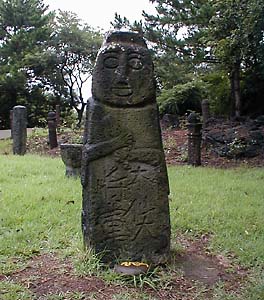



|
These phallic-looking fellows, called tolharubang ("grandfather figures")
are all over Cheju Island. Cheju is south of the Korean mainland and used to be the
number one destination for honeymooners (I know what you're thinking - but I really doubt
that the tolharubang have anything to do with that ;-). These days more couples go abroad
for their honeymoons, but Cheju is still big for vacations. Cheju is a volcanic island, and nearly everything is made of porous basalt. That includes the tolharubang. Oddly, not much is known about their origins, but Korean historians think they were carved in the mid-1700s. They were placed near the gates of walled cities on the island, as totems or guard dieties. In recent years they've been redistributed to various sites around Cheju. I suppose they make good tourist photo ops (look at us; we snapped them). There are 45 of them in all on Cheju, and they're pretty much the symbol of the island. The tolharubang on the right is on the grounds of the folklore museum in Cheju City. The one on the left, hogging Margaret's umbrella, lives in Cheju city. Behind him is the island's oldest wooden building, Kwandok-Jong. It was built in 1448 and restored in 1970. It was originally used for military training. There's a bit of a story behind this little scene. In 2000, we were on Cheju at Chusok and determined to do some sightseeing in spite of a steady drizzle. We found a reference to Kwandok-Jong in our guidebook and set out to find it. We asked a couple of taxi drivers to take us there, but they just gestured vaguely as if it were nearby and not worth driving to. We wandered for a while, trying to head in the general direction they indicated, but nothing looked much like it. By and by lunch sounded like a good idea, so we took a break for some nice bowls of seafood stew. So sated, Margaret gathered the guidebook and her Korean dictionary, and bravely slogged into yet another attempt at asking where Kwandok-Jong was, this time with the restaurant owner. After 5 or 10 minutes of mutual stumbling -- as an abstract concept, directions tend to be kind of hopeless in a language you barely know -- the restaurant owner motioned to us to follow him. He shouted something to his wife, put us in his own car, a weary, wheezing Hyundai Sonata, and personally drove us to Kwandok-Jong. It turned out to be 'way on the other side of town! We never figured out what those taxi drivers thought we were asking about. But we did get to see Kwandok-Jong. And its tolharubang. In the rain. This wasn't the only time something like this happened. Where are these surly Koreans that the disgruntled ESL teachers talk about? We certainly didn't find them. The Koreans we met were some of the friendliest and most helpful folks in the world. Koreans still treat us well years later, even as we read about supposed anti-American sentiment in Korea. If it's there, we haven't seen it. I think the answer is that in Korea, as in most places, you get back what you put in. How many countries have you visited where people call taxis for you, walk you to your bus to make sure you get the right one, get on their mobile phones and find you a hotel for the night, and even drive you to your destination themselves? I'm not talking about people who are paid to do these things, such as tour guides and tourist information clerks. These were just ordinary Koreans we met walking on the street, standing in subway stations, or waiting in line at bus stops. We found that Koreans are just nice people who treat foreigners well -- especially when they look lost.
|